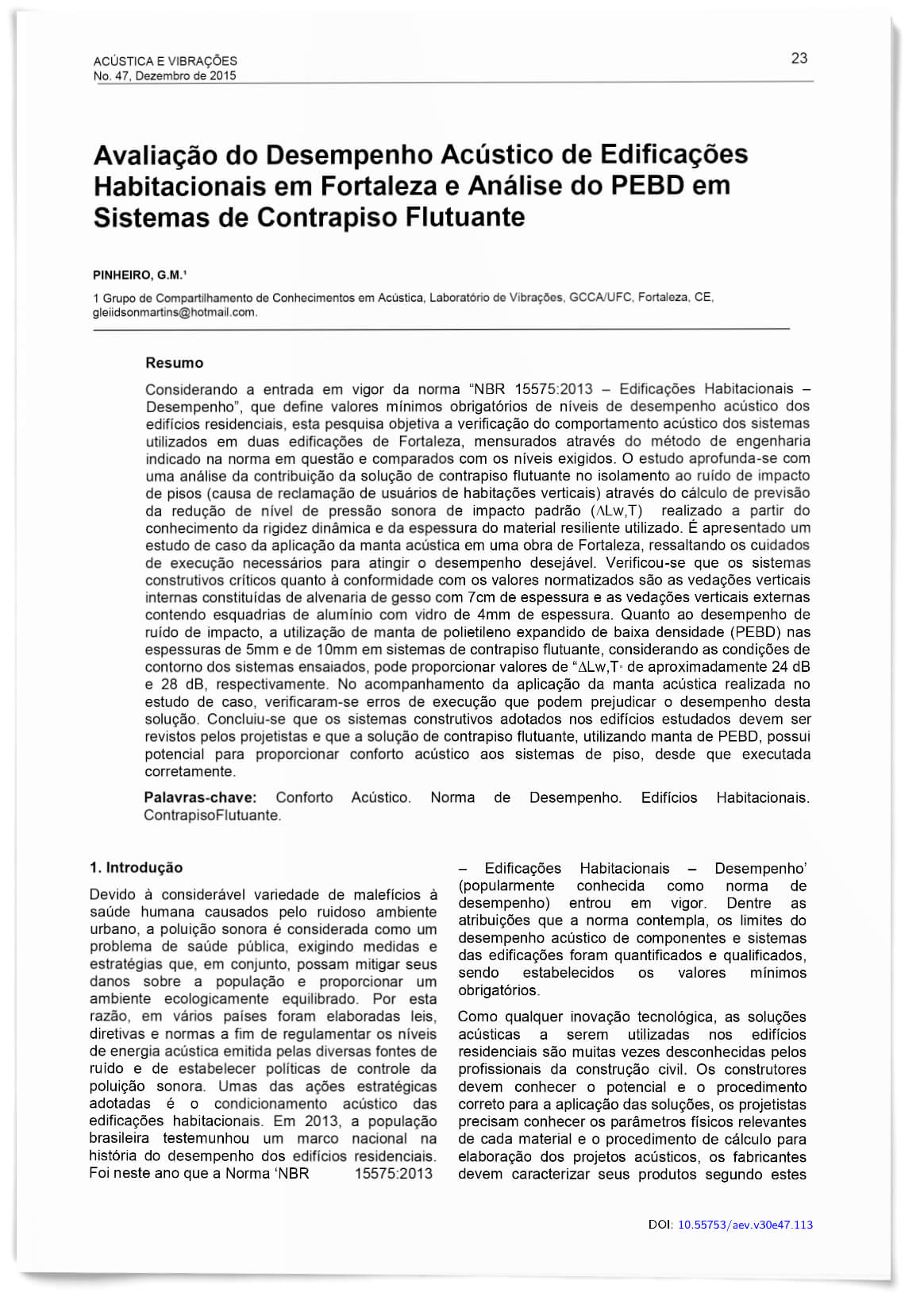Evaluation of the Acoustic Performance of Housing Buildings in Fortaleza and Analysis of Low Density Expanded Polyethylene (LDPE) in Floating Subfloor Systems
DOI:
https://doi.org/10.55753/aev.v30e47.113Keywords:
acoustic comfort, performance standard, housing buildings, floating screedAbstract
Considering the entry into force of the standard "NBR 15575:2013 - Housing Buildings - Performance", which defines mandatory minimum values of acoustic performance levels of residential buildings, this research aims to verify the acoustic behavior of the systems used in two buildings in Fortaleza, measured through the engineering method indicated in the standard in question and compared with the required levels. The study deepens with an analysis of the contribution of the floating screed solution in the insulation to the impact noise of floors (cause of complaint from users of vertical dwellings) through the prediction calculation of the reduction of the standard impact sound pressure level (∆ Lw,T) performed from the knowledge of the dynamic stiffness and thickness of the resilient material used. A case study of the application of the acoustic blanket in a work in Fortaleza is presented, highlighting the execution care necessary to achieve the desirable performance. It was found that the critical building systems in terms of compliance with the normatized values are the internal vertical fences made of 7cm thick plaster masonry and the external vertical fences containing aluminum frames with 4mm thick glass. As for impact noise performance, the use of low density expanded polyethylene (LDPE) blanket in 5mm and 10mm thicknesses in floating screed systems, considering the boundary conditions of the systems tested, can provide values of "∆Lw ,T” of approximately 24 dB and 28 dB, respectively. In the monitoring of the application of the acoustic blanket carried out in the case study, there were execution errors that could impair the performance of this solution. It was concluded that the constructive systems adopted in the buildings studied must be reviewed by the designers and that the floating subfloor solution, using LDPE blanket, has the potential to provide acoustic comfort to the floor systems, provided that it is correctly executed.
References
ASSOCIAÇÃO BRASILEIRA DE NORMAS TÉCNICAS. NBR 15575: Edificações Habitacionais - Desempenho. Rio de Janeiro: ABNT, 2013.
EN 12354-2 (2000). Building acoustics. Estimation of acoustic performance of building from the performance of elements. Part 2: Impact sound insulation between rooms.
EN ISO 717-2 (1996). Acoustics. Rating of soundinsulation in buildings and of buildings elements. Part 2: Impact sound.
NEVES, A.; ANTÔNIO J.; NOSSA A. Resultados Experimentais da Rigidez Dinâmica de Materiais Usados Sob Pavimentos Flutuantes., Coimbra, Acústica 2008, Universidade de Coimbra.
SCHIAVI, A.; BELLI, A. P.; RUSSO, F. Estimation of Acoustical Performance of Floating Floors from Dynamic Stiffness of Resilient Layers., Building Acoustics, v. 12, n. 2, 2005. doi: 10.1260/1351010054037938 DOI: https://doi.org/10.1260/1351010054037938
BISTAFA, S. R. Acústica Aplicada ao Controle do Ruído/ Sylvio R. Bistafa – 2.ed. revista, - São Paulo: Blucher, 2011.

Published
How to Cite
Issue
Section
License
Copyright (c) 2015 Acústica e Vibrações

This work is licensed under a Creative Commons Attribution-NonCommercial-ShareAlike 4.0 International License.




